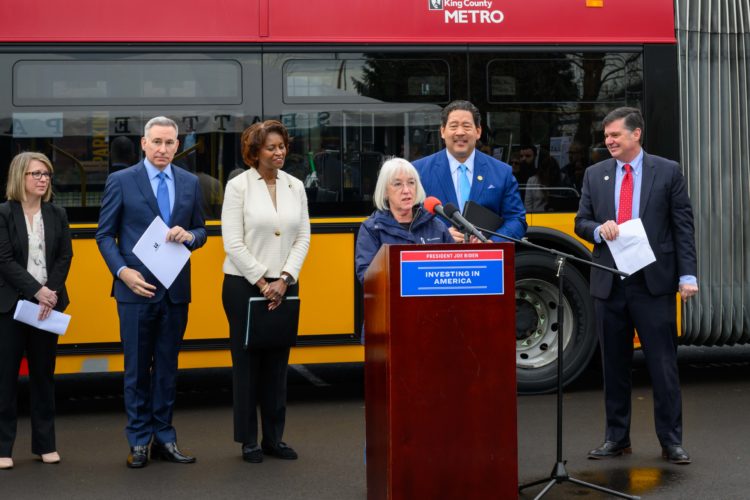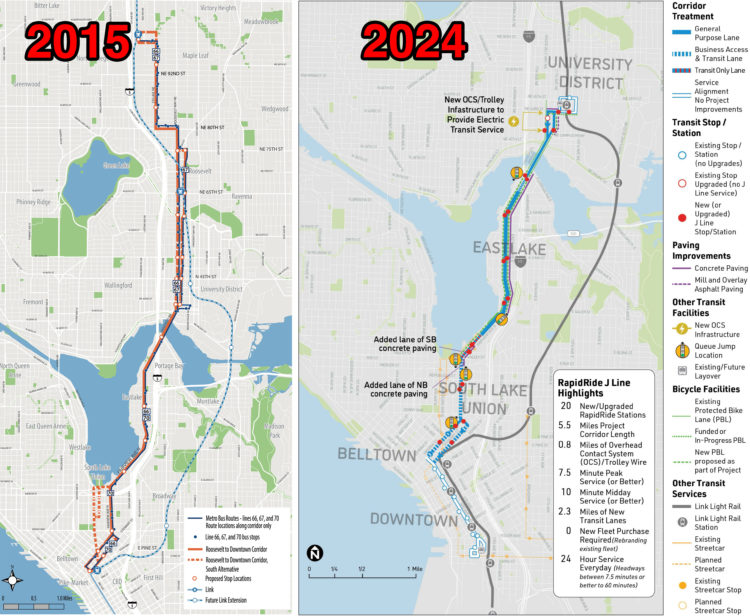Mayor, Sen. Murray celebrate full funding for RapidRide J and Eastlake bike lanes
 Photo from SDOT.
Photo from SDOT.If there were any concerns that a controversial push to kill the planned protected bike lanes on Eastlake Ave might succeed, Senator Patty Murray and Mayor Bruce Harrell just put that idea to bed for good.
When we're done here, we will new and upgraded stations, miles of new transit-only lanes, as well as new protected bike lanes, which will all help connect the U District with Eastlake and South Lake Union neighborhoods all the way to downtown," said Senator Murray during a press event Friday. And when we're done, this won't just mean fewer cars on the road and less time spent in traffic, it is also going to help us lower greenhouse emissions while creating 250 jobs."
Construction is scheduled to start as soon as" this year. Bus service should begin in 2027, though the bike lanes will hopefully be operational before then. A more detailed construction schedule is not yet available.
The joint press conference between Seattle and federal officials celebrated the $64.2 million in Federal Transit Administration funds that will go to the project, which will also replace a water main under Eastlake Ave and repave roadways. The budget for everything, including the water main and King County Metro station services, is about $167 million from seven sources, according to the Mayor's Office:
$64.2 million from the FTA Small Starts Grant and an additional $9.6 million from the Federal Highway Administration. In addition to the federal funding, the Washington State Department of Transportation and the University of Washington will each contribute $6 million to the project. The City will provide $43 million, mostly from the Levy to Move Seattle. Seattle Public Utilities also plans to invest an additional $28 million to build a new water main, which will be completed at the same time but is considered a separate project. In addition to providing daily bus service, Metro is contributing over $10 million toward station amenities and staff resources."

Since its inception, the RapidRide J project both shrunk in length and ballooned in scope. While it was once envisioned as a rapid bus line from downtown to Northgate Station, the northern terminus was cut back to U District Station as costs came into focus. But the scope of work, including the water main and roadway rebuild work, dramatically increased the full project cost. Cost increases like these (as well as the RapidRide G project on E Madison Street) threw a wrench in Seattle's plans for build so-called multimodal corridor" projects in nearly every neighborhood using funds from the 2015 Move Seattle Levy.
The project has also been heavily delayed. Our first story about the project (known then as the Roosevelt to Downtown High Capacity Transit project) was published nine years ago, and the target opening was 2021. A 2017 cost estimate pegged the downtown to 45th Street segment at $42.4 million in 2016 dollars, but did not include the pricey water main or roadway rebuild work. By 2017, the project was trimmed back to only reach Roosevelt Station and was estimated to cost $70 million. In 2019, the cost estimate had increased to $85.7 million, and the team added the roadway rebuild work for another $29.8 million just for Eastlake Ave. They were still targeting a 2024 completion and service start as recently as 2019. In 2020, the city officially cut the length back to its current scope and started a years-long environmental review and final design process, all of which was made more difficult due to the pandemic. By the end of all that, the project emerged in its current state with construction slated to begin this year and open for service in 2027.
Though the negatives of scope creep" are clear, including increased costs and delays, there are also benefits. If water main and road rebuilding work are needed anyway, it makes sense to do that work at the same time as the transit and bike project so that crews don't need to tear up the same street twice. But if Seattle wants to reach its transit and bike route improvement goals, the city needs to find ways to do so on a faster timeline and lower budget. Deciding when to go for the all-out rebuild versus targeted discrete improvements is difficult. The city cannot afford to use the RapidRide J/G method on every street. The next transportation levy will need to do a better job accounting for all these costs while also helping the city decide where faster and lower-cost options are more appropriate.
Video of the press event: